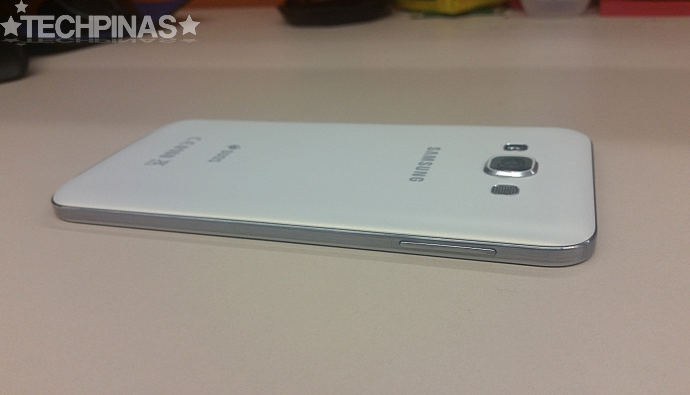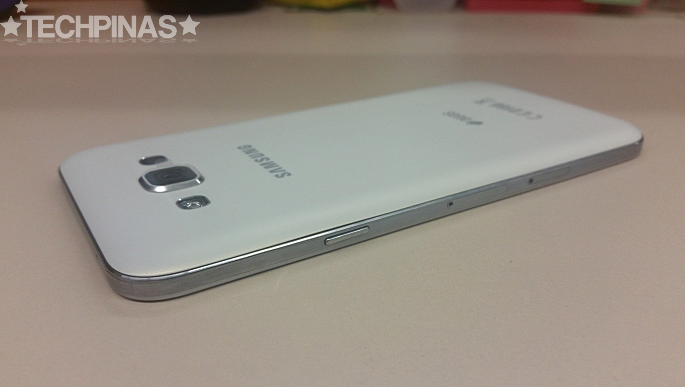Samsung Galaxy E7 Duos Price in the Philippines is Php 15,990 : Initial Impressions, Full Specs, In the Flesh Photos
Samsung has recently introduced its affordable midrange E-Series smartphones - consisting of two models currently: the Galaxy E5 and the Galaxy E7 - to the Philippine market.
E-Series Galaxy phones sport almost similar technical specifications as that of the more premium A-Series but instead of having an aluminum frame, E-Series features predominantly polycarbonate or plastic exteriors with chrome-plated accents; It’s a typical Samsung offering at the lower midrange level. But what’s different now is that, similar to the A-Series, these phones are equipped with Super AMOLED displays, which were only used previously on high-end smartphones of the Korean Giant.
The Samsung Galaxy E7 is the big brother of the E5. I am privileged to have been issued a white Duos (Dual SIM version) review unit, and I’ll be using this phone for a couple of days as my daily driver. I’ll be sharing my consumer experience on the Galaxy E7 from the point of view of a corporate professional/office worker. Hopefully, these insights would help potential buyers decide if they would consider getting this phone. This first review is about my initial impressions about it:
Pricing
The SGE7Duos' official retail price is Php 15,990.00, which is only half the value of flagship smartphones, For that amount, you can already enjoy a phablet that's equipped with a 5.5-inch HD Super AMOLED display, Quad Core 1.2 GHz ARM Cortex A53 CPU and Adreno 306 GPU based Qualcomm MSM8916 Snapdragon 410 chipset, 2GB RAM, 16GB Internal Storage with expandable storage (up to 64GB MicroSD), Android 4.4.4 KitKat operating system with TouchWiz skin, 13 MegaPixel autofocus rear camera with LED flash, 5 MP Front Cam for selfies, and a 2,950 mAH non-removable battery.
I must say that the E7 does not offer the best hardware on an Android smartphone I could purchase for that much money these days. But as a shopper and gadget fan, I know that there's no other phablet that sports a SuperAMOLED screen at this price category -- and this display type is top-notch. Additionally, I believe that these specs are already fully capable of giving me a delightful multimedia experience (which I’m going to confirm in my future written reviews). That, and also, buying a Samsung branded phone still carries a premium.
Design
Here’s a rundown of smartphone’s external physical hardware and visuals:

At 720 x 1280 display resolution, this dipslay is not the finest in terms of pixel density. Pixels could be noticed upon very close inspection. But the screen puts out impressive vibrant colors as can be expected from a Super AMOLED display. According to a Samsung representative, although the screen is not made of Corning Gorilla Glass, it is still equipped with a scratch-resistant tempered glass type of material. Although, he still recommended putting a screen protector just to be sure.





Initial Impressions
Upon seeing and handling the phone for the first time, my impression is that the Galaxy E7 is manufactured following Samsung’s new direction in terms of design philosophy (while retaining the slightly rounded look that best-selling Galaxy phones like the SGS3 and SGS4 have). The phone is really slim and light for its size. But in order to achieve impressive aesthetics, Samsung had to do away with some supposedly useful features that their phones have been known for. They took away the removable back cover and replaceable battery.
This may seem impractical at first, but looking back at my past phone usage, I haven’t actually purchased an extra battery pack as I use a power bank. And after 2 years of using a phone, I’m already due for upgrade anyway. Which is why a non-removable back cover and battery is not an issue for me.
The first time Mark handed me the E7 Duos, I instantly felt excited to use this phone as my daily driver -- but when I tried placing my microSIM inside the SIM tray, it did not fit. Upon checking the specs, I realized that the Galaxy E7 requires nano-SIM cards. If you ask me, I don’t think this was a well thought out hardware component of the phone. Why? Because it is very inconvenient for buyers to replace their SIM cards.

As I recall, the first phones that require nano-SIM cards are iPhones. iPhone users are not the target market for the Galaxy E7, because these people could afford to buy flagship devices! The E7 is for budget-conscious consumers who are looking to upgrade from an entry-level smartphone to a more feature-packed but still an affordable device. If I am buying an unlocked phone, I am probably still using a regular sized or even a micro-SIM (Even the Galaxy S5 still uses a micro-SIM).
So instead of being able to use the phone right out of the box, I now have to queue first at a Smart Business Center and have my SIM cards replaced, or pay to have it cut to size, and risk destroying the chip. As an example, I know someone who does not want to buy a new phone because she does not want to experience the hassle of replacing her SIM cards. That said, I'd love to speak to a Samsung representative regarding this to be enlightened as to why they went with nano-SIM on this release.
I can’t use the telephony features of the phone for now, as I would be making a trip to Smart after office.
On a positive note, I have shown this new smartphone to my officemates, and they were impressed by its looks, its beautiful screen, and its light-weight feel in the hand. It’s a natural eye-catcher and head-turner. That’s it for now. I’m basically using it as a small tablet for the meantime. I’ll be soon writing about its other features in the succeeding days. Thanks for reading.
E-Series Galaxy phones sport almost similar technical specifications as that of the more premium A-Series but instead of having an aluminum frame, E-Series features predominantly polycarbonate or plastic exteriors with chrome-plated accents; It’s a typical Samsung offering at the lower midrange level. But what’s different now is that, similar to the A-Series, these phones are equipped with Super AMOLED displays, which were only used previously on high-end smartphones of the Korean Giant.
The Samsung Galaxy E7 is the big brother of the E5. I am privileged to have been issued a white Duos (Dual SIM version) review unit, and I’ll be using this phone for a couple of days as my daily driver. I’ll be sharing my consumer experience on the Galaxy E7 from the point of view of a corporate professional/office worker. Hopefully, these insights would help potential buyers decide if they would consider getting this phone. This first review is about my initial impressions about it:
Pricing
The SGE7Duos' official retail price is Php 15,990.00, which is only half the value of flagship smartphones, For that amount, you can already enjoy a phablet that's equipped with a 5.5-inch HD Super AMOLED display, Quad Core 1.2 GHz ARM Cortex A53 CPU and Adreno 306 GPU based Qualcomm MSM8916 Snapdragon 410 chipset, 2GB RAM, 16GB Internal Storage with expandable storage (up to 64GB MicroSD), Android 4.4.4 KitKat operating system with TouchWiz skin, 13 MegaPixel autofocus rear camera with LED flash, 5 MP Front Cam for selfies, and a 2,950 mAH non-removable battery.
I must say that the E7 does not offer the best hardware on an Android smartphone I could purchase for that much money these days. But as a shopper and gadget fan, I know that there's no other phablet that sports a SuperAMOLED screen at this price category -- and this display type is top-notch. Additionally, I believe that these specs are already fully capable of giving me a delightful multimedia experience (which I’m going to confirm in my future written reviews). That, and also, buying a Samsung branded phone still carries a premium.
Design
Here’s a rundown of smartphone’s external physical hardware and visuals:

Front: 5.5-inch HD SuperAMOLED screen, a physical home button, two capacitive keys (multitasking panel and back buttons), and a 5 Megapixel front-facing camera.
At 720 x 1280 display resolution, this dipslay is not the finest in terms of pixel density. Pixels could be noticed upon very close inspection. But the screen puts out impressive vibrant colors as can be expected from a Super AMOLED display. According to a Samsung representative, although the screen is not made of Corning Gorilla Glass, it is still equipped with a scratch-resistant tempered glass type of material. Although, he still recommended putting a screen protector just to be sure.

Back: The back cover has a pearl-like 2-tone finish. It actually does not look like a cheap plastic material and it masks fingerprints effectively. I also appreciate the placement of the DUOS logo at the back. There is a 13MP camera with flash and a loudspeaker grill. I'd be careful not to scratch its pristine finish.

Top: Only the noise-cancellation mechanism could be found here

Bottom: There is a microUSB port, a 3.5 mm audio jack, and microphone. The placement of the audio jack at the bottom is notably new for a Samsung release.

Left: Only the volume rocker could be found here.

Right: There is the power button, and the 2 SIM card trays.
Upon seeing and handling the phone for the first time, my impression is that the Galaxy E7 is manufactured following Samsung’s new direction in terms of design philosophy (while retaining the slightly rounded look that best-selling Galaxy phones like the SGS3 and SGS4 have). The phone is really slim and light for its size. But in order to achieve impressive aesthetics, Samsung had to do away with some supposedly useful features that their phones have been known for. They took away the removable back cover and replaceable battery.
This may seem impractical at first, but looking back at my past phone usage, I haven’t actually purchased an extra battery pack as I use a power bank. And after 2 years of using a phone, I’m already due for upgrade anyway. Which is why a non-removable back cover and battery is not an issue for me.
The first time Mark handed me the E7 Duos, I instantly felt excited to use this phone as my daily driver -- but when I tried placing my microSIM inside the SIM tray, it did not fit. Upon checking the specs, I realized that the Galaxy E7 requires nano-SIM cards. If you ask me, I don’t think this was a well thought out hardware component of the phone. Why? Because it is very inconvenient for buyers to replace their SIM cards.

As I recall, the first phones that require nano-SIM cards are iPhones. iPhone users are not the target market for the Galaxy E7, because these people could afford to buy flagship devices! The E7 is for budget-conscious consumers who are looking to upgrade from an entry-level smartphone to a more feature-packed but still an affordable device. If I am buying an unlocked phone, I am probably still using a regular sized or even a micro-SIM (Even the Galaxy S5 still uses a micro-SIM).
So instead of being able to use the phone right out of the box, I now have to queue first at a Smart Business Center and have my SIM cards replaced, or pay to have it cut to size, and risk destroying the chip. As an example, I know someone who does not want to buy a new phone because she does not want to experience the hassle of replacing her SIM cards. That said, I'd love to speak to a Samsung representative regarding this to be enlightened as to why they went with nano-SIM on this release.
I can’t use the telephony features of the phone for now, as I would be making a trip to Smart after office.
On a positive note, I have shown this new smartphone to my officemates, and they were impressed by its looks, its beautiful screen, and its light-weight feel in the hand. It’s a natural eye-catcher and head-turner. That’s it for now. I’m basically using it as a small tablet for the meantime. I’ll be soon writing about its other features in the succeeding days. Thanks for reading.
 | TechPinas Correspondent Mon Arguelles is a graduate of Environmental Management, a joint program of the Ateneo De Manila University and University of San Francisco. He’s currently taking up his MBA. He is a part-time professor and environmental researcher but considers being updated about the latest technological trends to be one of his favorite pastimes. |
| Name | Samsung Galaxy E7 Duos |
| Type | Slate Form Factor (Full Touchscreen) |
| Price Category | Midrange |
| Dimensions | 151.3 x 77.2 x 7.3 mm |
| Weight | 141 grams |
| Available Colors | Black, White, Brown, Blue |
| Operating System | Android 4.4.4 KitKat with TouchWiz UI |
| Display | 5.5 inches (~71.4% screen-to-body ratio), 720 x 1280 pixels (~267 ppi pixel density), Super AMOLED capacitive touchscreen, capacitive touchscreen, 16M colors |
| Processor | Quad Core 1.2 GHz ARM Cortex A53 CPU, Adreno 306 GPU, Qualcomm MSM8916 Snapdragon 410 chipset |
| RAM | 2 GB RAM |
| Internal Storage | 16 GB, expandable via microSD card slot supporting up to 64GB |
| Camera | Main: 13 MegaPixels, 4128 x 3096 pixels, autofocus, LED flash Front: 5 MegaPixels |
| Video Capture | Full HD 1080p 30 frames per second for main camera (TBC), HD for front camera (TBC) |
| Audio and Video Playback | MP4, WMV, H.264, MP3, WAV, WMA, eAAC+, FLAC |
| Ports | microUSB v2.0, 3.5 mm audio jack |
| Connectivity | Wi-Fi 802.11 a/b/g/n, Wi-Fi Direct, DLNA, Wi-Fi hotspot, Bluetooth v4.0 with A2DP, EDR, 4G LTE Cat4 (150/50Mbps), 3G HSPA+ 42.2Mbps HSDPA, 5.76Mbps HSUPA, NFC |
| GPS | Yes, with GLONASS and A-GPS |
| FM Radio | Yes |
| Sensors | Accelerometer, Digital Compass, Gyroscope |
| Network | 2G Network GSM 850 / 900 / 1800 / 1900, 3G Network HSDPA 850 / 900 / 1900 / 2100, 4G LTE (TBD) |
| SIM Card Type | Dual nanoSIM |
| Battery | Non-removable 2,950 mAh Li-Ion battery |
| Uptime | 18 Hours of Talk Time, 88 Hours of Music Play, TBD |
| Value-Added Features | Ultra Power Saving Mode, Changeable Theme (Natural, Classic, Casual, Romantic), TouchWiz Interface |
| Announcement | October 2014 |
| Availability | Philippines: March 2015 |
| Price | Official: Philippines - Php 15,990 |
Labels:
Cellphone
Featured
Samsung
Samsung Galaxy E7 Duos
Samsung Galaxy E7 Duos Philippines
Samsung Galaxy E7 Duos Price
Samsung Galaxy E7 Philippines
Smartphones
TechPinas Correspondent
TechPinas Reviews




.jpg)